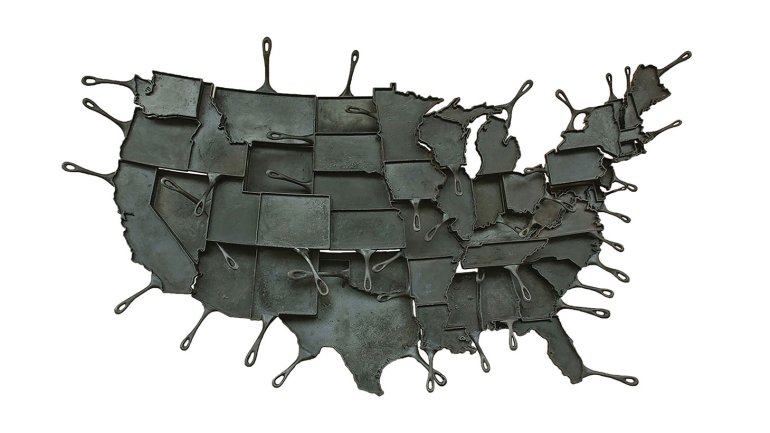American Skillet Co.
American Skillet Co.
Alisa Toninato’s first iron pour came when she was a sculpture student at Milwaukee Institute of Art & Design.
“We had this adjunct teacher who invited us to make molds and bring them by,” she says. “What I think he really wanted was people to help break iron.”
Curious about the process, she arrived at a field and was tasked with smashing radiators and vintage bathtubs into bite-size pieces of iron.
She also poured her own molds: a corn stalk, which she says turned out beautifully, and a waffle maker, which did not. But the scene – where iron is melted at more than 2,500 degrees and poured into molds to make castings – enthralled her.
“The fact that the furnace was handbuilt and powered by a Kirby vacuum on reverse was the first taste of me loving this scene,” she says. “I was like, this is the coolest, craziest thing I’ve ever seen.”
More than a decade later, Toninato still loves the down-and-dirty fierceness of working with iron, coupled with the finesse of mold design. She finds the unpredictable process a welcome challenge, too.
“There are about 700,000 variables in the casting process, and so much can go wrong,” says Toninato, 34, who lives in Madison, Wisconsin.
One design she expected would fail – a skillet in the shape of Wisconsin – eventually catapulted her career onto its path to success. She created the piece in 2010 to test out her first foundry, which fellow ironworkers had helped her build in Milwaukee.
“I was feeling super-proud of where we’re from and us pulling this off, and I just thought to make a Wisconsin skillet,” she says. “It was hilarious. It was so thin, it never should have come out. Then everybody there was like, ‘That is frickin’ awesome, and I want one.’ That was the first time anyone had ever said, ‘I want one’ of what I’m making,” says Toninato, who had been creating “weird, crazy kinetic sculptures that moved with music.”
From there, her idea morphed into interlocking cast-iron skillets of the Midwestern states, then into an eye-popping map of the Lower 48, a tour de force measuring about 10 by 7 feet and weighing close to 550 pounds. In 2012, the sculpture appeared on Martha Stewart’s TV show and Today, drawing national attention.
Meanwhile, Toninato had moved to Madison to be with her partner, carpenter Andrew McManigal, who helps run the skillet business, now spread across two companies: FeLion Studios, a custom design and finish shop that makes individual skillets (a 5-footer of Louisiana for a Ruth’s Chris Steak House, for example), and American Skillet Co., which contracts with a commercial foundry to make smaller, lighter, and less expensive state skillets for the home. The latter, founded in 2012, has allowed the duo to enter the wholesale market.
A Crate and Barrel order came last year during the shop’s inaugural participation in the International Home + Housewares Show in Chicago. “It was a small order – 1,000 pans – but we had to borrow a bunch of money to pull it off,” she said.
“This year, we’re hoping for two big retailers. I want to do more custom work, too.” To help facilitate that dream, the operation is moving to Cambridge, Wisconsin, 30 minutes east of Madison, to reduce costs and scale up production.
While Toninato’s art has taken a more commercial turn, she says the basics haven’t changed.
“Although I don’t make the weirdo art that doesn’t sell, the skillets are an extension of that,” she says. “Cookware involves people and performance, making food and eating it together. I love that.”
United Skillets of America
Lovefest: Every February, FeLion Studios holds Pour’n Yer Heart Out, a community iron pour. This year, at its eighth event, 3,000 pounds of iron were melted and used by artisans and novices to cast iron using simple molds. “It’s so great, because we’ll have people from ages 5 to 75 all working together,” Toninato says. “It’s also a chance to demystify our process. That’s important to me, because there’s a pretty major disconnect these days about how things are made.”
Horse whisperer: Raised in Green Bay, Wisconsin, Toninato spent much of her childhood on the back of a horse. “The barn was like the Little Rascals barn of English riding. If we could break the horses, we could ride for free. We were 12 or 14 years old, getting on totally green stallions. I rode at least five horses a day.” She says her ability to work with large, sensitive animals informs her art. “You have all this dirty, heavy stuff you have to move around all the time, but then you have these sensitive, nuanced things to be aware of.”
Democracy in action: Because each skillet costs thousands of dollars in start-up investment, American Skillet Co. is slowly rolling out the offerings. Available now are pans in the shape of the United States, Illinois, Michigan, Minnesota, New York, Oklahoma, Texas, and, of course, Wisconsin. Online votes from potential customers determine which state will be produced next.

